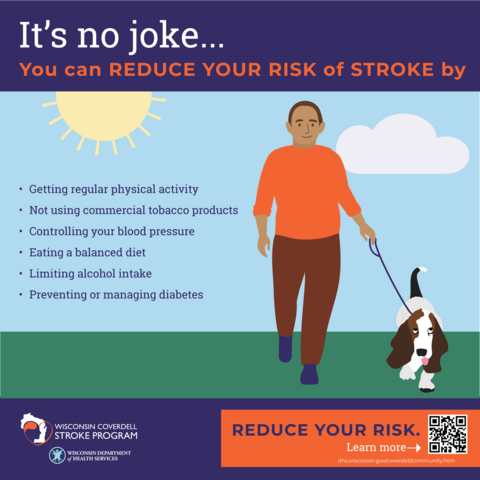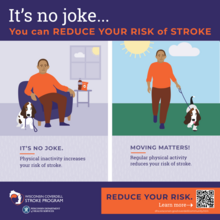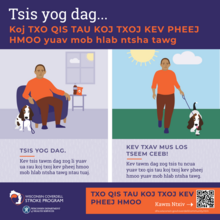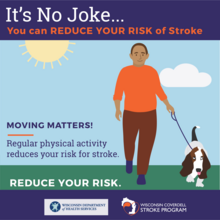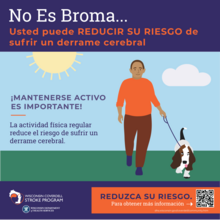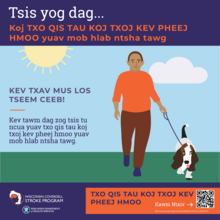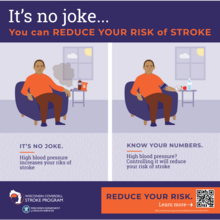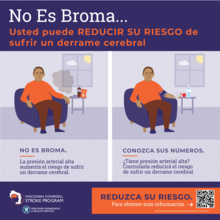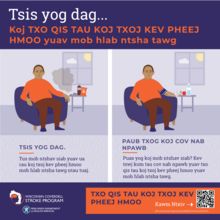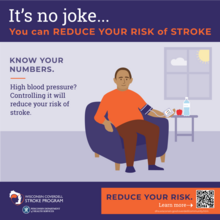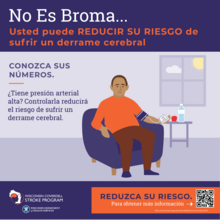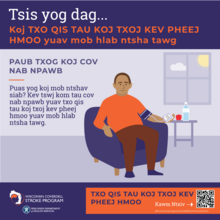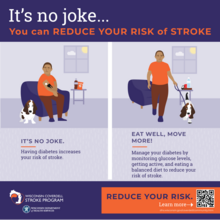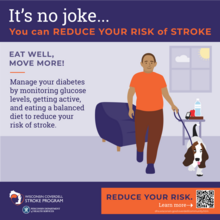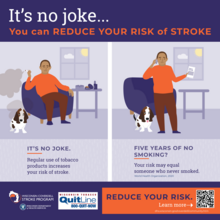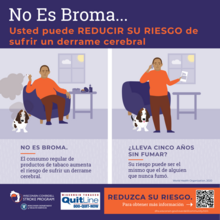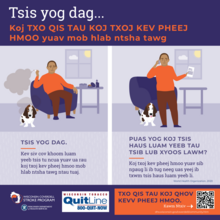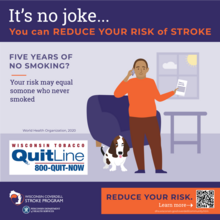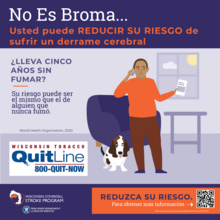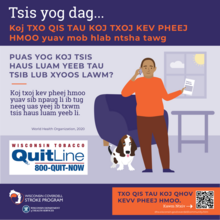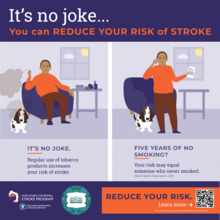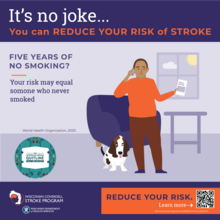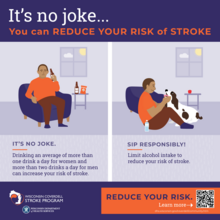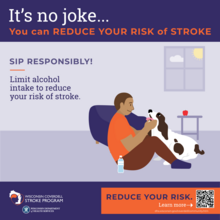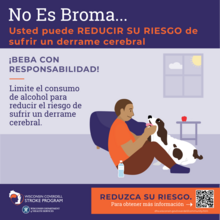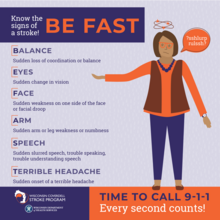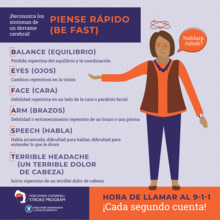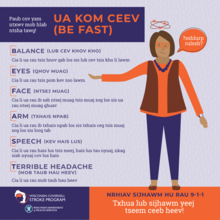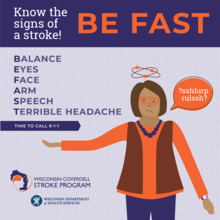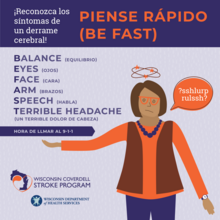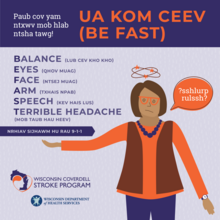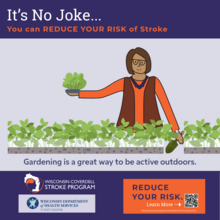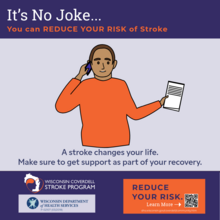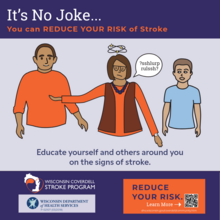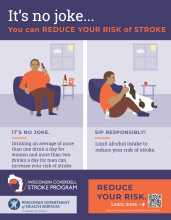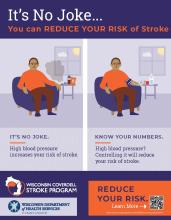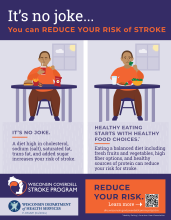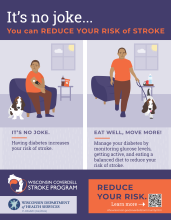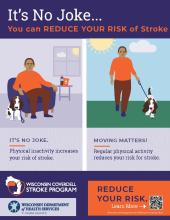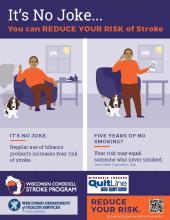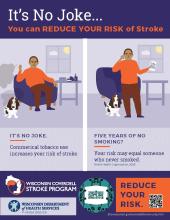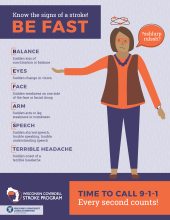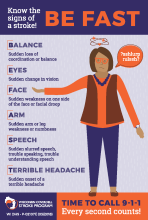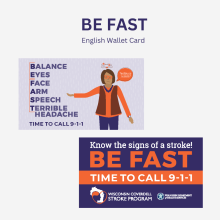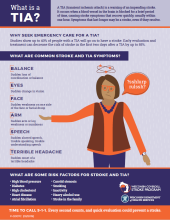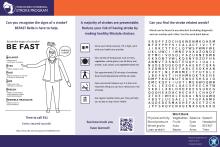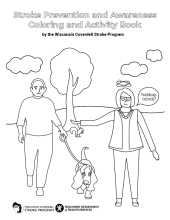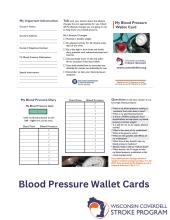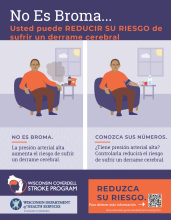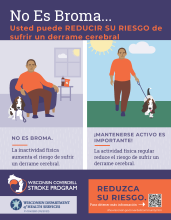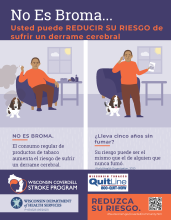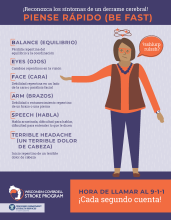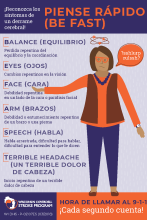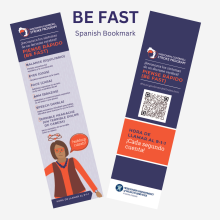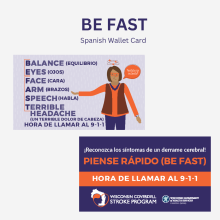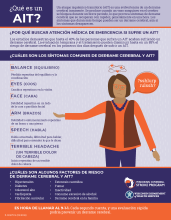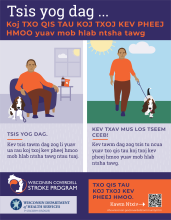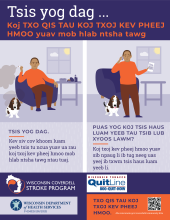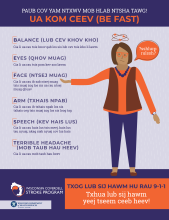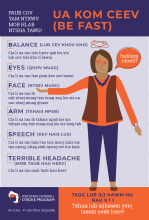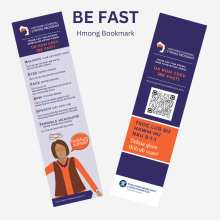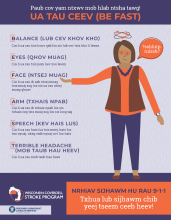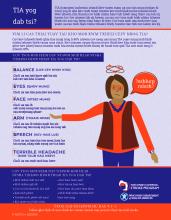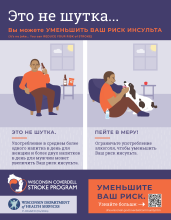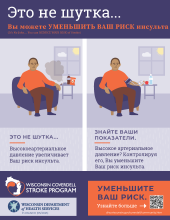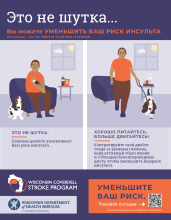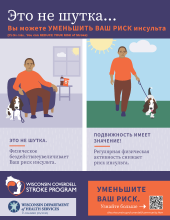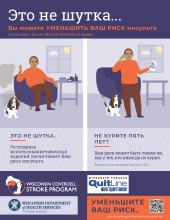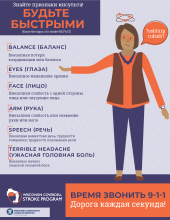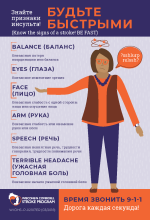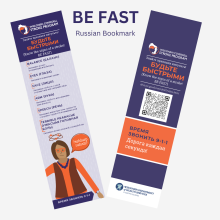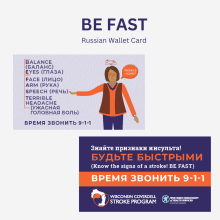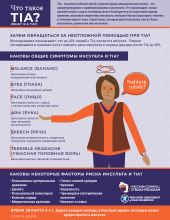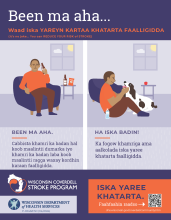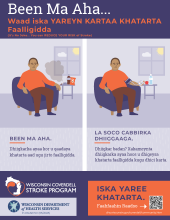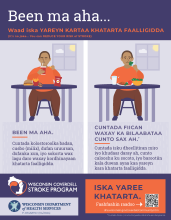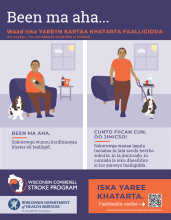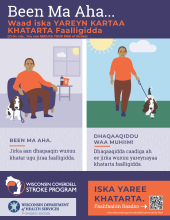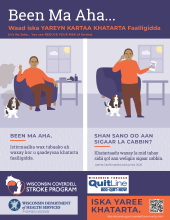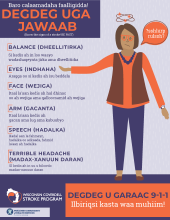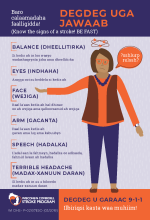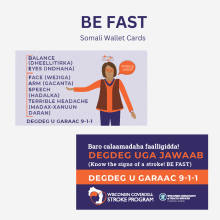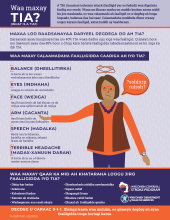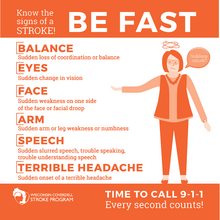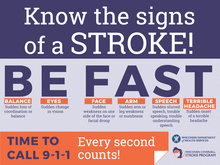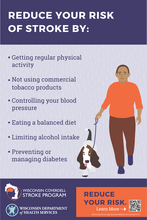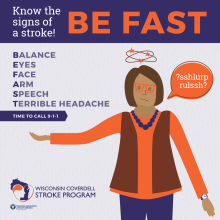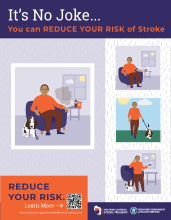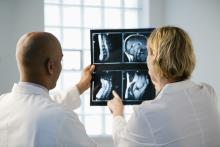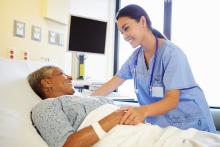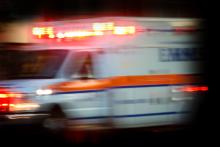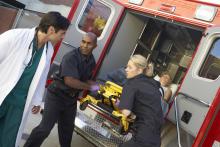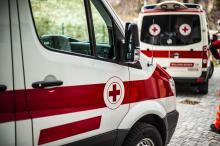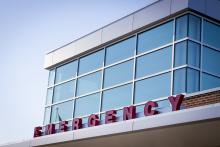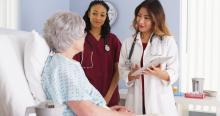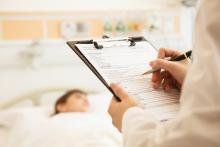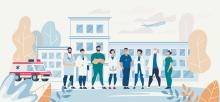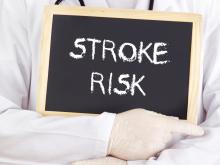Wisconsin Coverdell Stroke Program: BE FAST
Help raise stroke awareness
In Wisconsin, about 11,000 people experience a stroke and 2,700 Wisconsinites die from a stroke each year. Stroke can have devastating consequences not just for the person experiencing it–but for their family, friends, and co-workers who may all be impacted.
The good news? Strokes are largely preventable. The Wisconsin Department of Health Services offers campaigns to educate people on how to reduce their stroke risk, identify if someone is having a stroke, and actions to take in the event of a stroke.
BE FAST Bella materials teach people on the signs of stroke and encourage people to call 911 in the event of a stroke.
Risk Factor Rick materials focus on physical activity, monitoring blood pressure, reducing alcohol intake, quitting commercial tobacco use, and eating healthy foods.
You can play a critical role in raising awareness about identifying signs of a stroke and about stroke risk factors to your residents. By helping everyone know more about stroke, we can encourage Wisconsinites to be aware and take actions to reduce their stroke risk.
Join us in promoting stroke awareness by using the social media toolkit and downloadable files for promotional posters, bookmarks, activity sheets, and more.
Social media
Follow these steps to share stroke awareness messages through your social media channels.
- Click the link to download an image. These images are sized to work on most popular social media platforms.
- Right click to save the image on your computer.
- Prepare your post text and link (See our sample language for ideas).
- Add the hashtag #strokeawareness2025.
- Complete (or schedule) the post in your usual manner.
Sample post to encourage physical activity
Physical activity reduces your risk for #stroke. It lowers both anxiety and blood pressure, and it improves the quality of sleep. Learn more about the benefits of physical activity at
https://www.cdc.gov/physical-activity/php/about/index.html
Sample post to highlight managing blood pressure
It’s no joke. High blood pressure increases your risk of stroke. Know your numbers. If you have high blood pressure, controlling it will reduce your risk for #stroke. Learn more about blood pressure at https://www.heart.org/en/health-topics/high-blood-pressure/find-high-blood-pressure-tools--resources
Sample post encouraging managing chronic conditions like diabetes
Managing medical conditions, like obesity and diabetes, can reduce your risk for #stroke. Take the one-minute diabetes risk test at https://www.dhs.wisconsin.gov/prediabetes/index.htm, then talk with your primary care provider.
Sample post suggesting smoking cessation
It's no joke. Smoking commercial tobacco increases the risk of stroke, but after five years of no smoking, #stroke risk is the same as if you never smoked. Contact the Wisconsin Tobacco QuitLine at https://quitline.wisc.edu/ for help to stop smoking.
Sample post about getting support to stop smoking
It's no joke. Smoking commercial tobacco increases the risk of stroke, but after five years of no smoking, #stroke risk is the same as if you never smoked. Contact the American Indian QuitLine at https://quitline.wisc.edu/home/american-indian-program/ for help to stop smoking.
Sample post suggesting responsible consumption of alcoholic beverages
Alcohol consumption is linked to a number of other conditions that are associated with stroke risk. Learn about your risk factors and how to manage them athttps://www.dhs.wisconsin.gov/coverdell/index.htm
Sample post about signs of a stroke
Bella is showing signs of a stroke. It’s time to call 911. Every second counts! #BEFAST
Sample post about what to do if someone is having a stroke
If you or someone you know exhibits signs of a #stroke, act fast. Call 911. Learn more at https://www.dhs.wisconsin.gov/coverdell/community.htm #BEFAST
Sample posts specific to seasons and situations to encourage stroke prevention and awareness
Don’t let spring showers prevent you from being active! This can be as simple as grabbing your umbrella to take a move around outside, visiting your local recreation center or gym to enjoy indoor physical activity options, or doing some at home exercise. Engaging in physical activity reduces your risk for heart disease and #stroke. Learn other ways you can reduce your risk at https://www.dhs.wisconsin.gov/coverdell/community.htm
Download the Rick and Bella walk in the rain (English) social media graphic (PNG)
Springtime is a great time for gardening which can be great exercise and a stress reducing hobby. Engaging in physical activity reduces your risk for heart disease and #stroke. Learn other ways you can reduce your risk at https://www.dhs.wisconsin.gov/coverdell/community.htm
Download the Bella gardening (English) social media graphic (PNG)
May is #MentalHealthMonth and #StrokeMonth. Stroke survivors and their loved ones often experience challenges to their mental health after a #stroke. Help is available. Visit https://www.stroke.org/en/stroke-support-group-finder to search for an American Heart Association’s Stroke Support Group near you!
Download the Rick calls stroke support (English) social media graphic (PNG)
Do you know the signs of a stroke and what to do?
During #StrokeMonth educate yourself and others around you about the signs of stroke and how to reduce your risk. Start learning at https://www.dhs.wisconsin.gov/coverdell/community.htm
Download the Stroke symptom awareness (English) social media graphic (PNG)
Coverdell materials
Share stroke risk factor and BE FAST messages with posters, bookmarks, wallet cards, and more.
Community organizations, hospitals, EMS (emergency medical service) providers, and other patient care areas may download the PDF files, add their logo (optional), and print. Materials are organized by language (English, Spanish, Hmong, Russian, and Somali.
Production-ready artwork for promotional materials
Is your organization working on a stroke risk management or stroke awareness campaign? Download and use these branded PDF files to produce ad campaigns or ad specialty items.
BE FAST (stroke symptom awareness) advertising files:
Stroke risk factor advertising files:
Stroke prevention
Most strokes can be prevented. Encouraging people to make healthy lifestyle choices, like quitting smoking and helping them control any current health conditions, such as hypertension and diabetes can help reduce their risk of stroke. Read more from the CDC (Centers for Disease Control and Prevention) at Prevent Stroke: What Can You Do. Other risk factors of stroke and transient ischemic attack (TIA) include:
- High blood pressure
- Diabetes
- High cholesterol
- Heart disease
- Atrial fibrillation
- Carotid stenosis
- Smoking
- Inactivity
- Heavy alcohol use
- Stroke in the family
The Wisconsin Department of Health Services (DHS) runs active programs to help people prevent and understand conditions like Prediabetes and Heart Disease. We offer resources to help communities in their efforts to address Nutrition, Physical Activity, and Obesity and opportunities to learn more about commercial tobacco from the DHS Tobacco Prevention and Control Program.
Signs and symptoms of a stroke
It is important to recognize the signs and symptoms of a stroke. The BE FAST acronym can help people learn the six most common signs of stroke and the importance of calling 911 for timely care.
Balance – sudden loss of coordination or balance
Eyes – sudden change in vision
Face – sudden weakness on one side of the face or facial droop
Arm – sudden arm or leg weakness or numbness
Speech – sudden slurred speech, trouble speaking, trouble understanding speech
Terrible Headache – sudden onset of a terrible headache
Types of stroke
TIA
A TIA is a warning of an impending stroke.
It happens when a blood vessel in the brain is blocked for a brief period of time, causing stroke symptoms that recover quickly, usually within one hour.
Symptoms that last longer may be a stroke, even if they resolve.
Ischemic
Ischemic strokes account for about 87% of all strokes (American Stroke Association). It happens when a clot blocks blood flow to the brain. There are two types of ischemic stroke:
- Thrombotic strokes which are caused by a clot that forms in an artery that supplies blood to your brain.
- Embolic strokes happen when a clot forms somewhere else in your body and moves through the blood vessels to the brain.
Hemorrhagic
Hemorrhagic strokes account for about 13% of all strokes. It happens when a blood vessel ruptures causing bleeding in the brain. These are subdivided into two groups:
- Intracerebral hemorrhages (ICH) are caused by the brain tissue bleeding.
- Subarachnoid hemorrhages (SAH) usually happen when a blood vessel bursts in the brain (aneurysm). A sudden, terrible headache is the main symptom of this type of hemorrhagic stroke.
Post-stroke care
Recovery after a stroke looks and takes a different amount of time for everyone. Stroke rehabilitation can ease the transition home from the hospital and can help prevent a second stroke.
Stroke rehabilitation can include working with cognitive behavioral, occupational, physical, and speech therapy.
- Cognitive behavioral therapy (CBT) helps individuals identify and change thought patterns that have a negative influence on their behavior and emotions. CBT can help people cope with anxiety, frustration, anger, and depression after a stroke.
- Occupational therapy helps individuals improve skills related to daily life so they can live as independently as possible.
- Physical therapy helps individuals regain or improve physical abilities using exercises and equipment.
- Speech therapy involves personalized care plans to improve communication after a stroke.
Support within the community is extremely beneficial after a stroke. This includes accessing community-based resources and supports. Find a stroke support group near you with American Heart Association's Stroke Support Group Finder.
Community stroke education
BE FAST Bella
The Wisconsin Coverdell Stroke Program created BE FAST Bella to promote stroke awareness. BE FAST Bella can help people learn the signs of a stroke through recognition of the BE FAST acronym representing the six most common signs of stroke.
The phrase also teaches people to act quickly. They should call 911 right away if they see signs of a stroke in themselves or others.
Use our helpful BE FAST Bella materials with your community education efforts.
Quick stroke recognition is the first step to ensure timely medical care.
Risk Factor Rick
The Wisconsin Coverdell Stroke Program created Risk Factor Rick to promote awareness of risk factors of stroke. Risk Factor Rick can help people understand risk factors of stroke and what they can do to reduce their risk. The goal of these materials is ultimately to help prevent stroke.
We offer materials that show Rick demonstrating various risk factors of a stroke and ways to reduce these risks.
Use our helpful Risk Factor Rick materials with your community education efforts to help prevent stroke in your community.
Wisconsin Coverdell Stroke Program success stories
The Wisconsin Coverdell Stroke Program highlights the great work of community, EMS, and hospital partners across the state in stroke care.
Want to be featured as the next Coverdell success story? Contact Kyleen Maccoux at Kyleen.Maccoux@dhs.wisconsin.gov about highlighting your organization's achievements in stroke care including quality improvement projects, best practice, or partnerships.
Stroke Care Closer to Home: Building a Stroke Program at Beloit Memorial Hospital (PDF)
Beloit Health System in Beloit, Wisconsin, set a standard process across the stroke care continuum. They educate all staff who treat stroke patients, and they use virtual consults with neurologists via a telestroke network.
Every Minute Counts: Theda Clark Medical Center Sees Success in Stroke Care (PDF)
Theda Clark Medical Center in Neenah, Wisconsin, uses advanced notification procedures for stroke care. EMS alerts the hospital when a stroke is suspected, allowing the hospital to assemble the stroke team before the patient arrives. They also review stroke cases bimonthly. They use Get With The Guidelines® tools, and have a stroke champion in the emergency department.
The Nurse Practitioner Model: Achieving Exceptional Results at ProHealth Care, P-01286 (PDF)
ProHealth Care hospitals are located in Oconomowoc and Waukesha, Wisconsin. They developed standard processes across the stroke care journey. A nurse practitioner provides resources and education to patients right after a stroke and during a patient’s recovery. This allows patients to discuss what they find important during their recovery.
Community Education that Works: Moundview Memorial Sees Success in Stroke Outreach, P-01768 (PDF)
Gundersen Moundview Hospital and Clinics is in Friendship, Wisconsin. They analyzed stroke data to find ways to improve. They provide staff education. They reach out to the community by giving presentations to target audiences and distributing stroke outreach materials.
Teamwork Leads to Positive Patient Outcomes at Ascension All Saints, P-01870 (PDF)
Ascension All Saints Hospital in Racine, Wisconsin, has worked to coordinate seamless stroke care from EMS response to care in the hospital and during transfers. They provide protocols for EMS to use in the field and coordinate ongoing EMS education. They created a loop closure system to ensure that all care providers get results on the outcomes of the patients they treat.
Rethinking Inpatient Stroke Care Transitions at Gundersen Health System, P-01870A (PDF)
Gundersen Health System in La Crosse, Wisconsin, instituted a new procedure that transfers stable stroke patients from the emergency department directly to the neuroscience unit. This allows one provider and nursing team to deliver care throughout a patient’s stay.
Enhancing Communication and Teamwork to Reduce Door-to-Needle Time, P-1870B (PDF)
Froedtert & the Medical College of Wisconsin maximized communication efforts. They enhanced teamwork among multiple disciplines to reduce their door-to-needle time.
Getting to the Right Place First: Milwaukee County EMS Stroke Patient Transport, P-01870C (PDF)
Stroke care is changing rapidly. Current guidelines recommend developing regional systems of care. This can ensure rapid, efficient, and seamless care of acute stroke patients. In many areas of the state, a regional approach to destination planning isn’t an option. In Milwaukee County, however, it was. Milwaukee County EMS proved that bypassing patients to the appropriate hospital doesn’t increase the time or distance to care. It provides access to care that people couldn’t get otherwise.
Enhancing Emergency Department Efficiency Decreases Patient Disposition Times, P-01870D (PDF)
Poor efficiency in an emergency department can lead to longer hospital stays, overcrowding, and other delays in treatment. This motivated Aurora St. Luke’s South Shore to start new processes. Changes led to reduced delays to triage, treat, and transfer acute stroke patients in their emergency department.
Reducing Risk Factors of Stroke Patients after Discharge, P-01870E (PDF)
A dedicated nursing team works at the University of Wisconsin Hospitals and Clinics. They began a quality improvement project for secondary stroke prevention. They work to further engage patients in healthy lifestyle changes. The project provides continued education for stroke patients. Patients learn to reduce the risk factors for stroke after being discharged from the hospital.
A Stroke Survivor’s Story: Occurrence Through Recovery, P-01870F (PDF)
Carol suffered from a stroke while working as a quality improvement nurse at Ascension NE Wisconsin Saint Elizabeth Campus. Her story shows courage and inspiration throughout her stroke journey.
Celebrating 10 Years of the Wisconsin Coverdell Stroke Program, P-01870G (PDF)
The Wisconsin Coverdell Stroke Program celebrates 10 years of success. The program works with partners across the state to improve stroke care for all. This success story highlights our top achievements from the last decade. It also shows where we’re headed in the future.
The hard work of staff at Ascension Columbia Saint Mary’s Milwaukee paid off. They earned a Comprehensive Stroke Center Certification through The Joint Commission in December 2020. This story describes the lessons learned, barriers and challenges, and success factors. It also shows how Ascension Columbia Saint Mary’s Milwaukee maintains success.
The City of West Allis Fire Department increased stroke pre-notification documentation by educating paramedics and partnering with Advocate Aurora West Allis Medical Center. This partnership assists them in providing the best care to stroke patients in their community.
Froedtert Health partnered with three local students from the LAUNCH Medicine and Healthcare Strand to create a stroke awareness campaign. The campaign includes a stop animation video titled Stroke Prevention with Craig, which highlights the signs and symptoms of a stroke and the importance of calling 911.
Creating a Community: Ascension All Saints Stroke Support Group, P-01870K (PDF)
Ascension All Saints Hospital in Racine, Wisconsin created a community for stroke survivors, caregivers, and their loved ones within their monthly Stroke Support Group. This group allows attendees to access resources, education, and connect with others with shared experiences to increase resilience after stroke. This story describes the lessons learned as Ascension All Saints Hospital created and grows their Stroke Support Group. Learn more about starting a support group on American Stroke Association's Starting a Support Group page and find a support group near you with American Heart Association's Stroke Support Group Finder.
Resources
Use any of these resources to promote stroke awareness in your own way:
- American Heart Association
- American Stroke Association
- CDC: Division for Heart Disease and Stroke Prevention
- CDC: Division of Nutrition, Physical Activity, and Obesity
- CDC: Stroke
- Million Hearts
- National Association of Emergency Medical Technicians
- CDC: Paul Coverdell National Acute Stroke Program
- Wisconsin Coverdell Stroke Program: Publications and Materials
- Wisconsin Department of Health Services—Chronic Disease Prevention Program
- World Stroke Organization
- CDC video: A Stroke Can Happen at Any Age
- CDC video: What Happens in the Ambulance During a Stroke?
Contact us
Wisconsin Coverdell Stroke Program
DHSCoverdellStroke@dhs.wisconsin.gov

